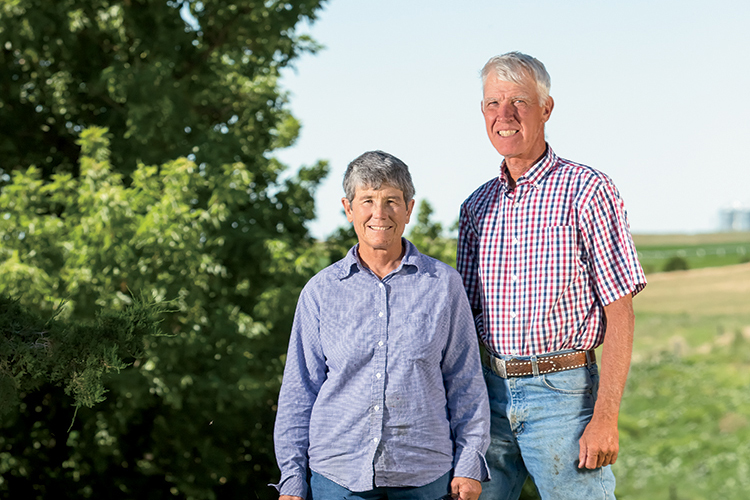Home > Nebraska > Nebraska Environment > Good Stewardship and Conservation Keep Nebraska Land Viable For the Future
Good Stewardship and Conservation Keep Nebraska Land Viable For the Future

Nancy Peterson of Gordon knew her calling at the tender age of 16.
“I grew up in Colorado with four brothers and 700 cows,” she recalls. “When I was 16, my dad asked us what we wanted to do with our lives. I said I was going to vet school so I could bring a skill home to the ranch. All I ever wanted to do was raise cows.”
Nancy made good on that promise. In 1996, she had the opportunity to practice veterinary medicine in the Sandhills region of Nebraska. Along with her husband, Rex, an architect, Nancy started her own small ranch with 200 cows in Gordon in 1998. From the beginning, they paid close attention to how they managed their land, knowing that the better care they took of it, the better it would take care of them.
“The pastures were in fairly good condition but had no defense against drought and blizzard,” Nancy recalls. “So we got a grant and started planting trees. We’ve planted 8,000 trees so far. We also did cross-fencing, and we rotate our pastures as often as possible to give them rest during the growing season. We’ve seen our pastures improve even in times of drought just by not using them for year-round grazing.”
Caring for the Animals
Over the years, their ranch, known as Plum Thicket Farms, has grown to include 310 pairs of cows. The family manages about 2,500 acres of farm ground. The operation owns half the land it works and leases the rest. Plum Thicket grows a multi-species cocktail of annual forages for grazing, which contributes to soil health while being a food source for the cattle. They have five working horses they use to help sort cattle and get from pasture to pasture efficiently.
As a veterinarian, Nancy has a deep commitment to animal care.
“We believe that taking care of the health and well-being of our livestock is our highest priority. It means making sure they have healthy, abundant pastures and fields to graze, well-balanced rations, plenty of clean water to drink, shelter against storms, and clean protected areas to calve on. It means we always handle them quietly and gently and provide working facilities in which we can handle them without scaring them and in ways that make them comfortable.”
 In winters, that means regardless as to whether it is Christmas morning or some other special occasion, the Petersons are out chopping ice to keep their water tanks ice free.
In winters, that means regardless as to whether it is Christmas morning or some other special occasion, the Petersons are out chopping ice to keep their water tanks ice free.
“The colder and nastier the weather, the more likely we are out in the elements making sure they are okay,” Nancy says. “If it storms during calving, we are often up all night, making sure new babies are brought into the calving shed and put in dry, clean pens. We provide for their good health through proper vaccination, strategic pasture rotations and excellent nutrition. That is what good stockmen do.”
Stewardship on the Farm
The Petersons’ son, Patrick, joined as a partner in 2004 after serving in the National Guard.
“When my parents started the ranch, I intended to end up here, but I joined the Guard first to pay for college,” Patrick says. “I ended up being deployed to Bosnia in 2002 and 2003 and not going back to college. Then, I was deployed to Iraq from 2005 to 2007.”
Between deployments, Patrick worked at the ranch and took an interest in no-till farming, a way of growing crops without disturbing the soil through tillage.
“When we first started, we didn’t know what we were doing, but we were sure the dirt wasn’t supposed to blow. The wind erosion was bad,” he says. “We started looking at no-till as a way to bring the land back to life. When I was in Iraq, the local NRD (Natural Resources District) sent me two books on managing cover crops properly and building soils. I had time on my hands, so I read them multiple times and came home with ideas.”
The benefits of no-till farming take years to reap, but they are well worth the effort.
“No-till isn’t easy. The first five years, you have lower production than traditional farming methods, but then between five and 10 years in, your yield gets back to what it was,” Nancy says. “After 10, you get the payoff with even better yields, better drought resistance and more organic material in the soil.”

Some of the Petersons’ soils have gone from 1.7 percent organic matter to 3.4 percent today.
“I consider that a big accomplishment,” Patrick says. “The ground is now more productive and more profitable. One of our big success stories is that even in dry years we have a lot of grass left. I have a lot of respect for my folks for putting in this range management system. It’s remarkable and very scientific.”
In 2016, Plum Thicket Farms was awarded the prestigious Leopold Conservation Award, which recognizes and celebrates outstanding private land stewardship.
“I love being out on our land and seeing a healthy pasture of grass and really good cattle,” Nancy says. “I love the fact this ground is better because we are here.”
Patrick agrees. “I’m a firm believer in a creator, and I have the privilege of working with creation every day,” he says. “I work with stuff that’s not man-made. It’s amazing seeing a crop coming out of the ground. We could learn everything there is to know, and there would still be things we don’t know. That’s what I love about agriculture. It assures you there’s always hope for tomorrow.”
![Nebraska 2017 [INFOGRAPHIC]](https://eadn-wc01-4177395.nxedge.io/wp-content/uploads/2020/05/Screen-Shot-2017-02-16-at-1.17.01-PM.jpg)



